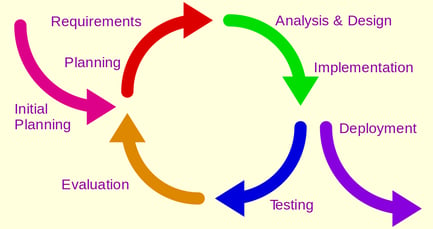2 min read
What is Rapid Application Development? 5 Reasons for Using RAD
Sales : Jul 16, 2017 12:00:00 AM


Rapid Application Development (RAD) is a software development methodology that focuses on rapid prototyping and application development to ensure faster product delivery. Unlike traditional waterfall development, RAD focuses on iterative development process a.k.a agile development. The idea of RAD was developed out of frustration from oldie methods which led to delay in application development. The term was first coined by James Martin who along with his colleagues developed a new development methodology i.e. Rapid Iterative Production Prototyping (RIPP). In 1991, this approach became the backbone of the book Rapid Application Development.
Phases of Rapid Application Development:

1. Business Modelling:
The core business models are decided and their priority of achievement is determined. The type and flow of information are decided between different business models. What information will be needed to decide the type of data structures and how will communication bridges between different business services be established is determined during this process.
2. Data Modelling:
The next phase involves review and analysis of data objects in relation to the business model. The attributes of these data sets are defined and their relevance to the business is clearly mapped out.
3. Process Modelling:
The data sets and business models are aligned to create a flow of information for different models. The process for development and change both are specified. In this stage, the process structure for adding, deleting, modifying or retrieving a data set are set in place.
4. Testing & Turnover:

The very reason for the popularity of RAD is because it focuses more on testing and turnover. Each prototype is tested by the user and feedback is collected. This feedback is used to modify the existing project structure and implement changes in accordance with the user interaction with the prototype. The test process is iterated for each prototype leading to fewer bugs in the final application.
Must read: A Complete Guide on How to Raise Funds for Mobile Apps
5 Advantages of Rapid Application Development:
1. Quick Delivery:
Since the entire project is divided into modules and each module is treated as a separate prototype the time spent in delivering is considerably reduced. Each prototype undergoes a separate testing phase and all components are finally winded together to create the final application. This ensures faster delivery of the software with lesser bugs.
2. Faster Market Analysis:
Since each prototype can be tested by its end user it becomes easier to survey the prospects for suggestions and improvements. Any change is easy to incorporate as it will affect one model of the application and not the entire development in one go.
3. User Feedback:
In traditional waterfall development, app development delays can result in very late arrival of the product. The idea might become obsolete or get stolen by the competitors. By using the MVP philosophy of development the need and psychology of the user are analyzed and further development is carried on only if the market seems fit.
4. Ease to incorporate changes:
Several elements of the application are processed at the same time. Since there is no process form of management, the application changes are easier to incorporate. Unlike waterfall development, the developers need not take a back step if changes are suggested in the product.
5. System Integration:
All the modules of the application are integrated from the very beginning leading to lesser issues in the final integration process. This leads to fewer bugs because all modules are properly synchronized from the very beginning.
When to use Rapid Application Development?
Rapid Application requires highly skilled developers, more budget and can only be implemented on large projects which can be splitted into modules. Also, it is not recommended to use this practice if it is difficult to collect user responses because the whole point of rapid application development is to collect user responses and move development forward accordingly.
If you are looking for someone to develop Mobile Apps for your business than you are at the right place. We at NewGenApps have 9 plus years of experience in developing applications that cater directly to their target segment.

Things to ask from an app development agency
The digital world has seen the maximum growth in the demand for mobile phones mainly smartphones. People have started relying on the data available...

Why Startups consider ROR for Rapid Application Development - And YOU should too?
What is Ruby on Rails? Ruby on Rails (ROR) is a web development framework developed in Ruby. It simplifies and abstracts repetitive tasks and aids...



